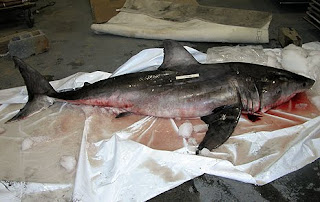Sistematika:
RED: Morski psi
PORODICA:Laminidae
ROD I VRSTA:Charcharodon charcharias
Belu ajkulu nazivaju i ljudozder ili bela smrt. Ovom putniku po svetskim morima, mozemo pripisati veliki broj napada na kupace i manje camce.
Telesne mere: duzina oko 3-6 m, moze da bude i duza , tezina prosecno od 700 kg do 1200 kg
Razmnozavanje: O njenima osobinam prilikom parenja se zna jako malo. Poznato je da radjaju zive maldunce i da zenka okoti jedno mladunce.
Nacin zivota: Ponasanje- samotnjak koji mora stalno da bude u pokretu
Hrana: jede sve vrste riba i toplokrvnih zivotinja , koje moze da ulovi
Zivotni vek: Nepoznat
Staniste: Moze se naci u svim morima sveta. Vise voli tople do umerene vode . Pojedine jedinke zive i u hladnim vodama oko juzneAustralije , Nove Skotske i Islanda.
Zastita vrste: Beli morski pasje stalno u pokretu , sto je razlog da se tacan broj jedinki ne moze utvrditi. Pretpostavlja se da nije brojna vrsta.
Beli morski pas napda tako , sto podigne vrh svoje njuske. Celjusti isturi napred i otvori ih , pa hvata svoju zrtvu kao u zamku.
Ishrana i nacin lova
Skoro svako zive bice u okeanu moze biti zrtva belog morskog psa. Ukoliko je veca , utoliko je zadovoljniji. Tune , ribe nalik na skuse i sabljarke su njegova najomiljenija hrana, dok morski lavovi, foke i delfini za njega nisu nista drugo nego prihvatljivija "uzina'', iako ih pojede.
Beli morski pas lovi pojedinacno, mada se ponekad oko mrtvog plena moze skupiti i veci broj jedinki i to zato sto razlivena krv primami i ostale bele ajkule koji su u blizini.
O kolicini dnevnog obroka ove ribe , nema podataka, jer je kolicina koju pojede zavisna od temperature vode i plena koji mu je u blizini. Pretpostavlja se da beli morski pas prozdire novi plen bez obzira na to , sto je kratko vreme pre toga pojeo veliku kolicinu hrane. Ako je to potrebno, moze da provede duzi period vremena bez hrane.
Od zivotnog znacaja za beog morskog psa je njuh. To je najznacajnije culo, kojim pronalazi plen u vodi. Na vrhu gubice ima hiljade sitnih otvora , koji oblikuju vazan nervni centar.
Zbog svog izuzetnog dobro razvijenog njuha moze da nanjusi i najmanje kolicine krvi u vodi.
Beli morski pas i covek
Pokazalo se da je za veliki broj napada morskih pasa na coveka , odgovoran upravo beli morski pas. O tome svedoce duboki tragovi zuba na rastrganim daskama za jedrenje i camcima, kao i mnogi oziljci na ljudima koji su preziveli napad.
 |
| Povrede nastale ujedom belog morskog psa |
Beli morski pas je omiljeni plen sportskih ribolovaca, koji ovakav ulov smatraju najvecimdostignucem u svojoj ribolovackoj karijeri. Belog morskog psa prepoznajemo po izrazenom trouglastom lednom peraju i snaznom repu u obliku polu meseca. Love ih uglavnom iz sporta jer im meso nije narocito ukusno. Meso mirise na urin i izlucevine.
O belom morskom psu se zna neverovatno malo. Posmatranje belog morskog psa u njegovoj prirodnoj sredini su bili neuspesni. Beli morski pas je stalno u pokretu. U akvarijumu ga je vrlo tesko drzati jer ce u tom slucaju tesko preziveti.
Nacin zivota
Vecina naucnika pretpostavlja da kada beli morski pas dostigne odredjenu proporciju izmedju svoje duzine i tezine , promeni svoje zivotne navike. To izgleda kao kad bi zivotinje koje su bile ''zadovoljne'' zivotom uz povrsinu mora , promenile svoje navike i lovista i zauvek nestale u dubinam okeana. Tako se predpostavlja da beli morski pas isto kao i usnaca, posto dostigne odredjenu velicinu , promeni pol i umesto muzijaka postane zenka. Mozda je ovo nacin na koji priroda omogucava prezivljavanje ogranicenom broju jedinki.
Tako samo velika i zdrava riba moze na svet da donese maldunce i doprinese opstanku vrste. Morski psi koji polazu jaja imaju drugaciji nacin zivota.
 |
| Karakteristicno ledjno peraje koje viri iz povrsine prilikom plivanja |
Posebnosti
Zube ima kao trakasta testera.. Dugi su oko sedam do osam santimetara i trouglastog oblika. Nazubljeni su po rubovima pa im je zbog toga lakse da zgrabe plen. Poput ostalih morskih pasa i beli morski pas, odlomljene ili slomljene zube zameni novim. Zubi su mu poput trakaste testere , stalno rastu i ostaju u celjusti sve dok nije potrebno da zamene stare ili istupljene. Kada beli morski pas izgubi zub , ''traka'' se pokrene i pojavi se nov zub.
 |
| Zub belog morskog psa |
|
|
Da li ste znali?
Ugriz morskog psa ima snagu od nekoliko tona po kvadratnom santimetru.
Beli morski pas moze da nanjusi kap krvi u 4.6 miliona litara vode.
Ako bi belog morskog psa vukli kroz vodu u ornutom pravcu uggusio bih se ubrzo.
Neki morski psi radjaju zive mladunce a neki polazu jaja.
Beli morski pas mora da pliva 24h dnevno brzinom od 3.5 km/h da bi dobio dovoljno kiseonika u svoj krvotok.
http://en.wikipedia.org/wiki/White_shark
http://animals.howstuffworks.com/fish/great-white.htm

















